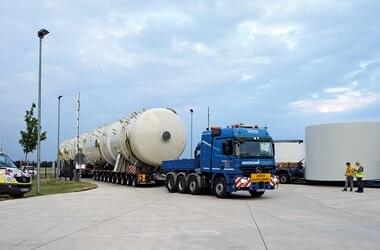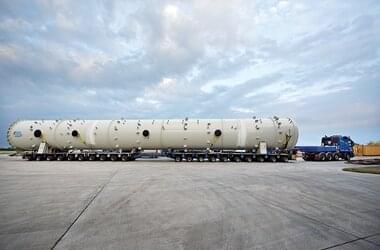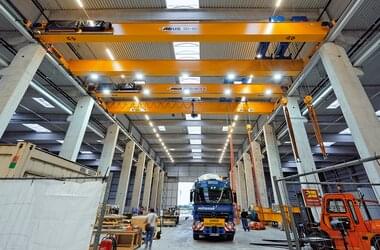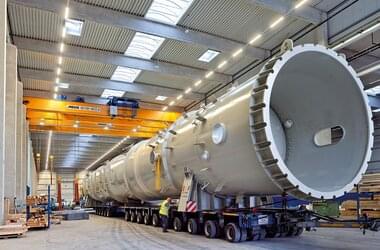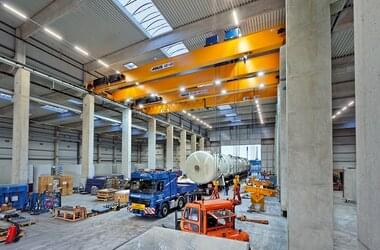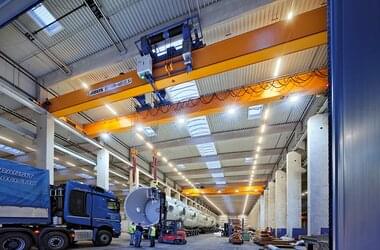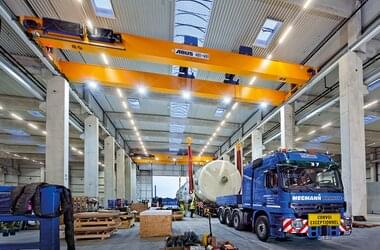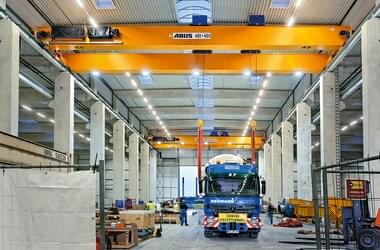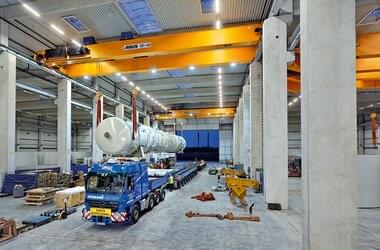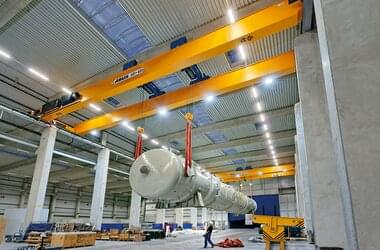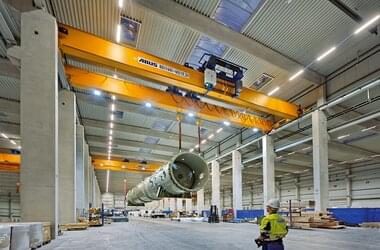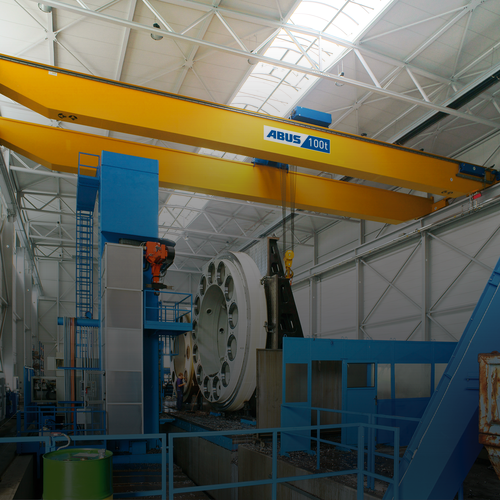ABUS EOT cranes for multipurpose logistics building handling heavy goods
The special purpose vehicle of the German haulage firm Hegmann (www.hegmann-transit.com) makes its way slowly onto the premises of the heavy cargo terminal where they are already waiting for its heavy load, a pressure vessel for BASF. Inside the logistics building they unload the pressure vessel from the lorry and then they process and store it there. Hegmann Transit GmbH & Co. KG is a company specialised in, and passionate about, safe and reliable transport of large and heavy cargo weighing up to 400 tonnes within Germany and Europe and even worldwide. The family-run company, now in its third generation, can look back to almost 100 years of history: Karl Hegmann founded the company in 1920 with horse and waggon. The following generations were successful in developing the different lines of business imposing ever stricter requirements as to logistics and transport in a more and more globalised world thus setting the course for a secure future of the company. Today more than 100 staff, situated in various locations, ensure that the transport requirements of their customers all over the world are satisfied by employing 120 vehicles including special purpose vehicles as well as support and service vehicles. Goods and parts are transported on road as well as in vessels across water. The combination of different transport means might make it necessary at times to temporarily store these goods. In order to meet this demand Hegmann opened a heavy cargo terminal (www.schwerlast-terminal.de) in Wesel, which is in the northwest of Germany on the Dutch border situated at the confluence of the Lippe River and the Rhine, in 2014 with future ship connection. This cargo terminal sees heavy building elements such as gear units for wind farms stored and loaded but also large goods such as raw parts for the ICE intercity express. Storage of coils is also planned. The storage capacity of the terminal has almost always been exhausted since the day the terminal was opened.
Forwarding agent Hegmann relies on ABUS crane systems—installed in the building which is about 15 m high—to unload lorries on their Wesel premises and to transport their goods within the building. Two double girder cranes of the ZLK type travel in each of the two outer bays: the cranes can lift 25 tonnes each and they can work individually or together when long or heavy goods need to be moved. One crane of each crane pair features an additional hoist in the form of an independently travelling crab which means that these cranes can also be used individually to transport long goods in the cross direction of the bay. The centre bay of the building has two EOT cranes installed with 80 t SWL. These cranes have two hoists with 40 tonnes lifting capacity each sitting on individually travelling trolleys which enables them to lift even the heaviest cargos in tandem operation. The cranes are also fitted with tandem control for this purpose. Load can be safely attached in four positions and transported as in the case of the pressure vessel if both cranes and both hoists are used in tandem operation.
Centre load hooks make it possible to attach compact loads comprised of weights of up to 150 tonnes via heavy goods crossbeams exactly matched to the cranes. These lifting beams are constructed modularly; they can be modified to fit the 25 t SWL cranes in the outer bays. One of the 80 t cranes has an additional hoist of 12.5 tonnes lifting capacity in the shape of a side running trolley, a so-called cantilever crab. This hoist has been designed as a winch and is classified as FEM group 3m. This hoist can reach lifting speeds of up to 30 metres per minute depending on the load and it is mainly going to be used for unloading coils from ships—that is where every minute counts.
All cranes feature strong LED lights to lighten up the respective work zones. ABUS remote controls “ABURemote Joystick” are used to control the cranes. The remote controls allow the crane users to observe and to move these heavy loads within the bays from a place of safety.
It is planned to extend the crane track of the centre bay to reach the outdoor area in 2017 / 2018. This crane track will then sit above the dock so that the cranes can be used to load and unload boats. The crane track will be designed as a self-supporting steel structure suspended from a pylon. This impressive structure and the cranes will be visible from quite a distance. The ABUS cranes have already been prepared for partial use outdoors: rain covers made from weatherproof plastic have been installed to protect the crane travel motors, the panels, and the hoist trolleys from bad weather conditions; there is also a wind measuring system in place that will warn the crane user via a well visible warning light should the wind be freshening so that the crane may be secured or moved back inside. The cranes have also been painted with a special paint system that is to act as corrosion protection when the crane is operating outside.

